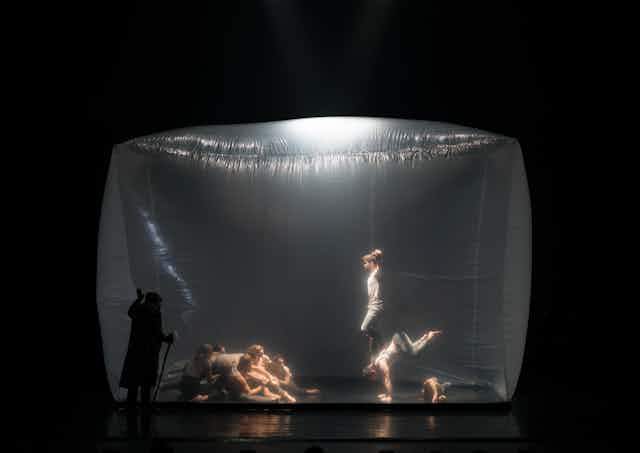Review: En Masse, Brisbane Festival
According to their artistic director, Yaron Lifschitz, Circa’s En Masse “speaks of fresh starts and old endings, of violence and tenderness, of groups and individuals, of destruction and abundant hope”. This world premiere, as part of the Brisbane Festival, presents these paradoxes to create a work that defies genre and challenges theatrical possibilities.
The first act, titled Endings, combines songs from Austrian composer Franz Schubert’s late song cycles Die Winterreise (The Winter’s Journey) and Schwanengesang (Swansong) with industrial and electronic compositions by Klara Lewis.
Read more: Decoding the music masterpieces: Schubert's Winterreise
En Masse opens with a projected quote, “The crisis consists precisely in the fact that the old is dying and the new cannot be born” (from Italian philosopher Antonio Gramsci). The set of the first act is dominated by a large plastic scrim and, subsequently, a translucent plastic cube containing the performers. This cube deflates later in the piece creating a sense of entrapment and claustrophobia that the performers fight against.
The Schubert songs, including Ständchen, Gute Nacht and Der Doppelgänger, are performed with magnificent control and an astonishing range of dynamics by English tenor Robert Murray and pianist Tamara-Anna Cislowska. Murray’s soft singing is particularly ravishing.
He is dressed as a vagabond-type character who mostly observes the cataclysmic activity of the acrobats around him, although the occasional interaction with the other performers provides some very moving moments. There seem to be subtle references here to the Wanderer of Richard Wagner’s Ring Cycle and to the Winter’s Journey of Schubert’s protagonist and he becomes an outsider to the events around him.
Read more: Explainer: Wagner's Ring Cycle, Der Ring des Nibelungen
At times, there is a slight disconnect between the frantic movements of the performers and the serenity of the Schubert songs, although this contrast also provides interesting theatrical conflict. Similarly, the contrast between Lewis’ industrial compositions and Schubert’s songs is effective but raises questions of cohesion.
The acrobatic movements of the first act feature extreme writhing, twitching and contortion as the performers fight the end of the world. The ensemble work ranges through duos, trios, solos and group pieces and is sometimes violent and shocking, while also quite tender in contrasting moments.
The incredible physical control of the Circa acrobats, and their ability to make bodies seem weightless, is breathtaking. A particularly notable moment was when a tower of three men slowly toppled forward into a flawless roll. This performance has all of the jaw-dropping features of outstanding circus performance. Yet the theatrical elements and integration of music and narrative transcend these thrills to create arresting physical theatre that sits somewhere between ballet, contemporary dance and circus.

The second half, titled Beginnings, is absolutely the jewel in the crown of this programme. Russian composer Igor Stravinsky’s masterwork, The Rite of Spring, originally composed for Sergei Diaghilev’s controversial Ballet Russes in 1913, is presented here in a piano duet version, played by renowned pianists Tamara-Anna Cislowska and Michael Kieran Harvey.
The musical performance of this work alone is extraordinary, with both pianists drawing an enormous range of colours from the score, at once evoking many of the familiar orchestral sounds of the piece while also celebrating the full range of timbral possibilities from the pianos. Particularly impressive was Harvey playing this complex piece from memory, no doubt made even more complex by the separation of the pianists across the stage of the Playhouse.

This first-ever circus setting of The Rite of Spring opens with the quote, “There is no document of civilisation that is not at the same time a document of barbarism” (from German philosopher Walter Benjamin), and the movement certainly explores this theme. The entire ensemble of acrobats performs through most of the second half and a constant theme of rising and falling is evident in the staging, as well as images of circles and growth.
One particularly evocative image was a female performer ascending a “spiral staircase” of hands and bodies formed by the other performers, rising higher and higher as the music swelled. These acrobats constantly seem to defy gravity as the movements become progressively more frantic. Throughout this half, the music and movement is much more closely matched.
Comparisons could be drawn to Pina Bausch’s famous 1975 staging of Stravinsky’s masterpiece, although Lifschitz’ narrative diverges from the original while extending the possibilities of the range of movement possible in a work of this kind.
Special mention must also be made of the evocative lighting design by Yaron Lifschitz and Richard Clark and Libby McDonnell’s simple but effective costume design.
With En Masse, Circa have created a grand masterwork that challenges the boundaries of dance, theatre, music and circus to present a dystopian view of endings and beginnings.
En Masse is being staged as part of the Brisbane Festival until September 22.

